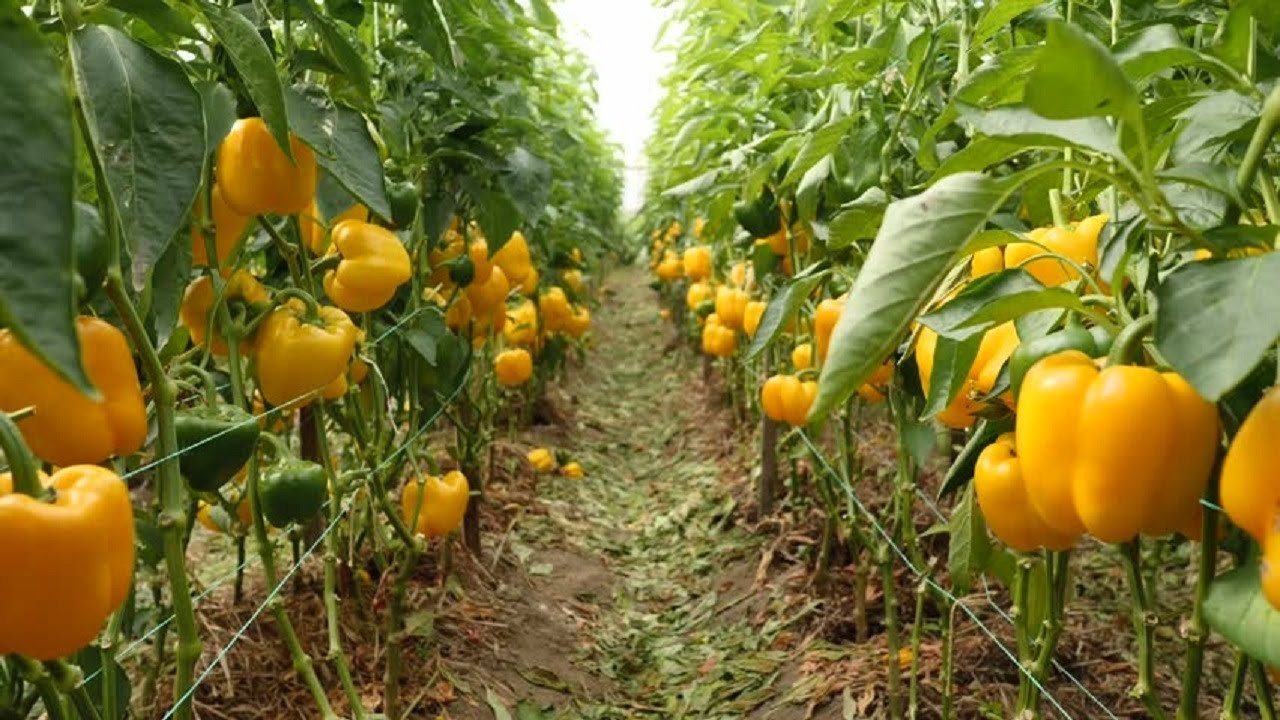Capsicums are a high-demand vegetable in India. It is a multipurpose vegetable that is essential to Chinese cuisine and has increased, boosting its standing in the farming community. Capsicums are tasty vegetables that are also a healthy addition to our diets because they are a high source of beta-carotene, vitamin C, and vitamin A. Farmers all around India are adopting cutting-edge cultivars as demand rises, opening up the possibility of year-round production and higher yields.
Learn more about the places where it is grown, varieties and steps for cultivation below:
Zones Where Capsicum Is Cultivated :
Indian states, including Haryana, Punjab, Jharkhand, Uttar Pradesh, and Karnataka, were major producers of capsicum. It is currently spreading over the country since it has grown so well. Capsicum has established itself as a mainstay in Indian agriculture, coming in a variety of colors, from eye-catching green to tempting red and yellow.
Advanced Varieties:
1. Bombay (Red Capsicum): Known for its swift maturity tall, and strong plants, the Bombay variety thrives in shady locations. Initially dark green, the chilli turns red upon ripening, boasting a longer shelf life.
2. Orobel (Yellow Capsicum): Flourishing in cooler climates, Orobel yields fruits weighing approximately 150 grams. Resistant to diseases, it adapts well to both greenhouse and open-field cultivation.
3. Arka Gaurav: Recognized by yellow and green leaves, this variety features thick pulp fruits weighing 130-150 grams. Post-ripening, the fruits exhibit an orange or light yellow hue, with an average production of 16 tonnes per hectare.
4. Yellow Wonder: Medium-height plants with broad leaves characterise this variety. Dark green fruits with distinct bulges yield an average potential of 120-140 quintals per hectare.
5. Solan Hybrid 2: A high-yielding hybrid with fruits ready in 60 to 65 days, it boasts disease resistance. Tall plants with square-shaped fruits offer an impressive yield potential of 325-375 quintals per hectare.
6. California Wonder: California Wonder, which has dark green, glossy fruits and medium-height plants, is a well-liked option. The crop has a thick peel and can yield an average of 125–150 quintals per hectare when harvested in 75 days.
A Step-by-Step Guide To Capsicum Cultivation
1. Selecting the Right Variety:
Based on the market demand and the climate where you live, choose an appropriate type. Because of their versatility and yield, varieties including Arka Gaurav, Orobel, and Bombay (red and red capsicum) are well-liked.
2. Preparing the Soil:
Capsicum grows in well-drained, loamy soil, making it essential for farmers using Mahindra Arjun 605 or Mahindra 265 tractors. Conduct a soil test to determine nutrient levels, and subsequently enrich the soil with organic matter like well-rotted compost or farmyard manure to improve fertility.
3. Sowing Seeds:
Start by sowing capsicum seeds in seed trays or nursery beds. Use a quality potting mix and maintain optimum moisture. Transplant the seedlings when they have 4-6 leaves and are around 6-8 weeks old.
4. Transplantation:
Prepare the main field by ploughing and levelling. Transplant the seedlings with a spacing of 40 cm between plants and 60 cm between rows. Ensure that the transplants have a well-developed root system.
5. Watering:
Capsicum requires consistent moisture, especially during flowering and fruiting. Irrigate the crop regularly, avoiding waterlogging. Drip irrigation is an efficient method, preventing water on foliage and minimising diseases.
6. Mulching:
Apply mulch around the plants to conserve moisture, suppress weeds, and maintain soil temperature. Plastic mulching is a common practice, preventing weed competition and enhancing overall crop health.
7. Nutrient Management:
Monitor nutrient requirements and apply fertilisers accordingly. Capsicum plants benefit from a balanced fertiliser with a higher potassium content during flowering and fruiting. Split the fertiliser application for better absorption.
8. Support and Pruning:
As the plants grow, provide support using stakes to prevent breakage due to the weight of the fruits. Prune excessive foliage to improve air circulation and light penetration, reducing the risk of diseases.
9. Pest and Disease Control:
Regularly scout for pests like aphids, thrips, and caterpillars. Implement integrated pest management (IPM) practices, including the use of neem oil and beneficial insects. Fungal diseases can be controlled by ensuring proper ventilation and avoiding overwatering.
10. Harvesting:
Capsicum is usually ready to be picked about 65-70 days after you transplant it, whether you’re growing it outdoors or in a greenhouse. Harvest the fruits when they reach the size and colour you want. To make the harvesting process easy, use sharp scissors or pruning shears. If you own a Mahindra Arjun 605 or trust the Mahindra 265, these sturdy tools can help you harvest efficiently without harming the plants.
11. Post-Harvest Handling:
Handle harvested capsicum with care to prevent bruising. Store them in a cool, dry place or refrigerate to extend shelf life. Proper post-harvest handling ensures a high-quality product for the market.
Market Dynamics:
Due to higher demand, coloured capsicum commands higher prices in the market. Green capsicum only sells for Rs 40 to 80 per kg, whereas coloured capsicum can fetch up to Rs 250 per kg. At this cost, growing capsicum can be a profitable endeavour for farmers who are willing to invest the necessary time and energy.
Conclusion:
The introduction of improved varieties is causing a shift in the production of capsicum in India. These cultivars provide farmers with a range of options, from the rapid maturity of Bombay to the disease resistance of Orobel and the remarkable yield of Arka Gaurav. For farmers looking to boost profitability and earn income all year round, adopting these sophisticated kinds of capsicum is becoming a calculated decision as the market demand for the crop rises. When grown properly and with a thorough understanding of the market, capsicum becomes not just a delicious food but also a viable business opportunity for farmers all around the country


